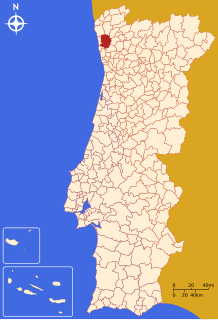Barcelos | |
|---|---|
|
Top: The entrance to the city of Barcelos coming from the parish of Barcelinhos; middle: Igreja Matriz de Barcelos; City Hall and statue of Bishop António Barroso; bottom: The medieval tower; Tower view of the Church of Bom Jesus da Cruz and the gardens | |
 | |
| Coordinates: 41°31′N 8°37′W / 41.517°N 8.617°W | |
| Country | |
| Region | Norte |
| Intermunic. comm. | Cávado |
| District | Braga |
| Parishes | 60 |
| Government | |
| • President | Mário Constantino Lopes (PSD) |
| Area | |
• Total | 378.90 km2 (146.29 sq mi) |
| Population (2011) | |
• Total | 120,391 |
| • Density | 320/km2 (820/sq mi) |
| Time zone | UTC+00:00 (WET) |
| • Summer (DST) | UTC+01:00 (WEST) |
| Website | http://www.cm-barcelos.pt |
Barcelos (Portuguese pronunciation: [bɐɾˈsɛluʃ] ) is a city and a municipality in Braga District in the Minho Province, in the north of Portugal. The population in 2011 was 120,391,[1] in an area of 378.90 km2.[2] With 60 parishes, it is the municipality with the highest number of parishes in the country. It is one of the growing municipalities in the country, and is well known for its textile and adobe industries, as well as its horseback riding events and "figurado" style of pottery, which are comical figurines with accentuated features of farmers, folk musicians, and nativity scene characters.
Barcelos is part of the UNESCO Creative Cities Network as a Crafts and Folk Art City.[3]
- ^ Instituto Nacional de Estatística
- ^ Eurostat Archived October 7, 2012, at the Wayback Machine
- ^ "Barcelos | Creative Cities Network". en.unesco.org. Retrieved 2018-10-03.






